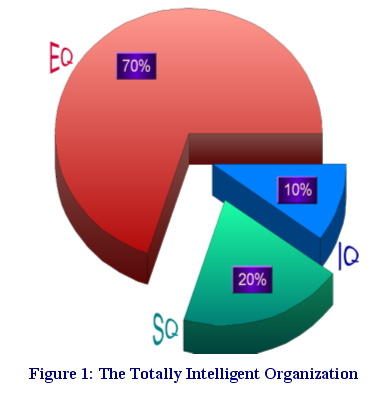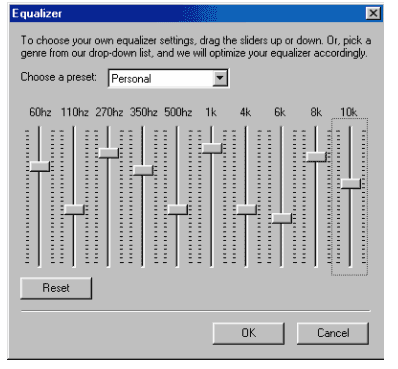The New Balance Sheet: Emotionally Intelligent Workplaces
By Michael E. Rock, Ed.D. | November 30, 2004
Given what we know about what we're good at and who we are, I believe we are faced with a great opportunity. For most of the past century we have worked in what are really rather horrible, mechanistic organizations. We now have the possibility to break free and create more imaginative, human organizations of human shape and size. So my message is that we should be proactive about this.
– Professor Nigel Nicholson, Emerald Now, November 2004.[1]
I am going to make a simple assumption right at the beginning of my article: the average person who thinks about what an emotionally intelligent organization looks like would be hard-pressed not to come up with factors that we have always known about 'good' and 'great' organizations.
Such organizations treat people well; respect and courtesy are part of the fabric of these organizations. They are also focused organizations; not only are they emotionally intelligent, they are also strategically intelligent. To connect with one of Tom Peters' notions from his best-selling book of the 1980s, they 'stick to the knitting.'
What Jim Collins in his best-selling book From Good to Great has added is that the CEOs of only a few great companies from over a thousand companies exhibited profound humility. The focus was on the company, on how others were doing, and how to get others to build a future worth going to.
In short, therefore, we can easily say that emotionally intelligent organizations are so because the very senior people model the necessary behaviours and create the life-giving context to build their future worth going to. From one point of view, it is almost incomprehensible that we should have to prove that being emotionally intelligent is a worthwhile endeavour or that it may contribute to business sustainability. While research over the past few decades shows that a happy employee is not necessarily a productive employee (because the employee may simply be content and not get more productively engaged in tasks), we do know that when productive employees are fairly and intelligently rewarded for their efforts, they are more productive.
It's the emotionally intelligent organization that provides the context for graciousness and excellence in thought, word and deed because the senior team models such behaviours.
Many perhaps will insist that 'mental smarts' is what separates out the winners and losers in business and in life. The reason? Because that's the way they've been raised and taught. There's no question that mental intelligence is critical to living a worthwhile life. But, how many 'mentally smart' people have you known or worked with who lack the finesse to initiate and foster good relationships? For mentally smart people who are able to do so, what you will find accompanying this set of mental smarts is another set of skills: 'emotional smarts,' or those skills most often referred to as emotional intelligence skills.
Thus, the emotionally intelligent organization – to refer back to a diagram in article #1 of this series – contains the following dimensions, and in these proportions:

Figure 1: The Totally Intelligent Organization
The IQ slice of this workplace pie encompasses the necessary skills to know what the business is all about, to understand the business, and to grasp the implications of new developments in the industry. The competitive advantage with such mental smarts is that a company – with the right knowledgeable people in place – will be able to outknow the competition. This ability to outknow the competition is a sine qua non of business success because it is the knowledge capital needed to build a future worth going to. It is a threshold requirement, since much more is needed for it to maximize itself; that is why it merits a more or less 10% impact to the overall success of the organization.
The SQ slice of this workplace pie embraces the clear and manageable strategic intelligence goals and directions that provide the needed focus. The competitive advantage with such strategic smarts is that this company – with the right focus and direction in place – will be able to outperform the competition. This ability to outperform the competition is a sine qua non of business success because it is the strategic capital needed to build a future worth going to. It is an operational requirement, but much more is needed for it to maximize itself; that is why it merits a more or less 20% impact to the overall success of the organization.
The EQ slice of this workplace pie captures what is the context and essential dynamics to make the corporate intelligence (IQ) and the strategic intelligence (SQ) successful. Dr. Margaret Wheatley writes that leadership creates the context, but that the context can only be created through relationship-building. The competitive advantage with such emotional smarts is that a company – with healthy working relationships – will be able to outpace the competition. This ability to outpace the competition is a sine qua non of business success because it is the emotional capital needed to build a future worth going to. It is a relationship requirement; that is why it merits a more or less 70% impact to the overall success of the organization.
The emotionally intelligent organization, in short, is a relationship intelligent organization. One of the most beautiful and lyrical descriptions of emotional intelligence that I have ever read was written by a colleague and retired English professor, Howard Hopkins, M.A.:
Every response you give to another person involves your intellect and your emotions. The intellect composes the message, and the emotions provide animation and grace. Emotion is to the message what music is to the lyric. Without the tune, would anyone ever remember the lyric? The skill to combine intellect and emotion in this dramatic and powerful fashion is emotional intelligence, and it possesses the power to elevate even the common exchanges of everyday encounters from the base level of me-and-you to the sublimity of I-and-Thou!
The above description of emotional intelligence, for me, is the best there is. Think about what goes on in the office; visualize your last visit to a retail store; consider a telephone experience you had with a customer service agent. Was the tune off key and you walked away swearing that you would never darken the door of the company again, or felt that all you wanted to do was quit? Or, did you experience animation and grace from your encounter? If you did, you experienced relationship gold! We always remember those who treat us well, who give us a reason to come back, or to spend more time with them.
Dr. Reuven BarOn, author of the BarOn Emotional Quotient-Inventoryâ„¢ (or EQ-iâ„¢, as it has come to be known), after 17 years of research (1980-1997), discovered five major components to EQ architecture (which, in turn, accounts for the 15 EQ competencies he developed for the Inventory). What is fascinating with his research is the fact that it is not gender-biased or racially-biased. To date, the EQ-iâ„¢ assessment has been taken by many people in many countries. It is a self-report, but with very reliable and valid research properties.[2] In my experience, both in teaching business undergraduates and graduates at the MA (in leadership) and MBA levels, as well as in my business consulting practice, it has proven to be uncannily accurate. I have come to call EQ “the start of a conversation.” With the results (15 pages), a wonderful conversation (with self, with others) is then possible with each and every person.
The five components are listed in Table 1. A short explanation of their application follows below.
| Scientific EQ Components and Sub-Factors | ||
| Component | Competencies | Meaning |
| Intrapersonal |
1.Emotional Self-Awareness 2.Assertiveness 3.Self-Regard 4.Self-Actualization 5.Independence |
Assesses one's inner self and his/her awareness of that self, indicates people who are in touch with their feelings, who feel good about themselves, who feel positive about what they are doing in their lives and who emotionally on their own, not through the 'psychological pocket' of others. |
| Interpersonal |
6.Empathy 7.Interpersonal Relationship 8.Social Responsibility |
Taps interpersonal skills, indicates people who are responsible and dependable, with good social skills (understanding, interacting, relating). |
| Adaptability |
9.Problem Solving 10.Reality Testing 11.Flexibility |
Indicates success in emotionally coping with one's environment and effectiveness in assessing and dealing with problematic situations. |
| Stress Management |
12.Stress Tolerance 13.Impulse Control |
Shows one's ability to withstand stress without falling apart or losing control. |
| General Mood |
14.Happiness 15.Optimism |
Measures one's ability to enjoy life as well as one's outlook on life and overall feeling of contentment. |
Just a quick overview of Table 1 is enough to prove that a very definite set of skills are required to be emotionally intelligent. One of the ways I look at this set of skills is through the image of an equalizer (as in Figure 2 below).

Figure 2: The EQ Equalizer
What's fascinating for me with this image of the EQ Equalizer is the concept of what I call feathering. Feathering means that in order for me to calibrate or adjust the individual levers to get the proper sound from the radio, I must adjust or feather the levers. If, in frustration, I simply jam all the levers to the top, or whack them all to the bottom, I will simply end up with a sound that is less than pleasant. In an analogous way, it is the same thing in applying our EQ set of skills. Depending on the context and circumstances, we must feather the individual competencies so that we get the result and experience the best of what we want. A collections agent who uses too much empathy and not enough problem solving could not do a good job. In a similar way, a psychologist, in not interpreting the context carefully enough, might use too much assertiveness and not enough empathy. EQ, in this sense, is all about judgment, judgment, judgment.
To sum up, therefore: emotionally intelligent organizations encourage everyone to use their best judgment, but to do that they also know that this challenge includes the IQ, SQ, and EQ dimensions – in other words, insight, vision, and conversation. We live and work in what is now called the emotional economy. As contemporary people we are experience-driven; we are also relationship people. Organizations are at their peril if they ignore this emotional and relational reality. The new currency is actually relationships and they happen in conversing organizations.
In the new economy, conversations are the most important form of work. Conversations are the way knowledge workers discover what they know, share it with other colleagues, and in the process create new knowledge in the organization. Conversations inside and outside the company are the chief mechanism for making change and renewal an ongoing part of the company's culture. One of the many paradoxes of the new economy is that conversation – traditionally regarded as a waste of time – is in fact the key resource for competing on time.
-- Alan Weber, co-founder of Fast Company magazine
Footnotes
[1] "Spotlight on Nigel Nicholson," Emerald Now, November 2004.
http://titania.emeraldinsight.com/vl=1963930/cl=22/nw=1/rpsv/now/
[2] The world rights to the EQ-iâ„¢ are the property of Multi-Health Systems, Inc., 3770 Victoria Park Avenue, Toronto, ON M2H 3M6. Tel: 1-800-268-6011; website: http://www.mhs.com/
Other Articles in this Series
#1: The Ethics of Hope
#2: Leadership as Presence
#3: Emotionally Intelligent Workplaces
#4: The Fine Art of Business
#5: The New Balance Sheet





